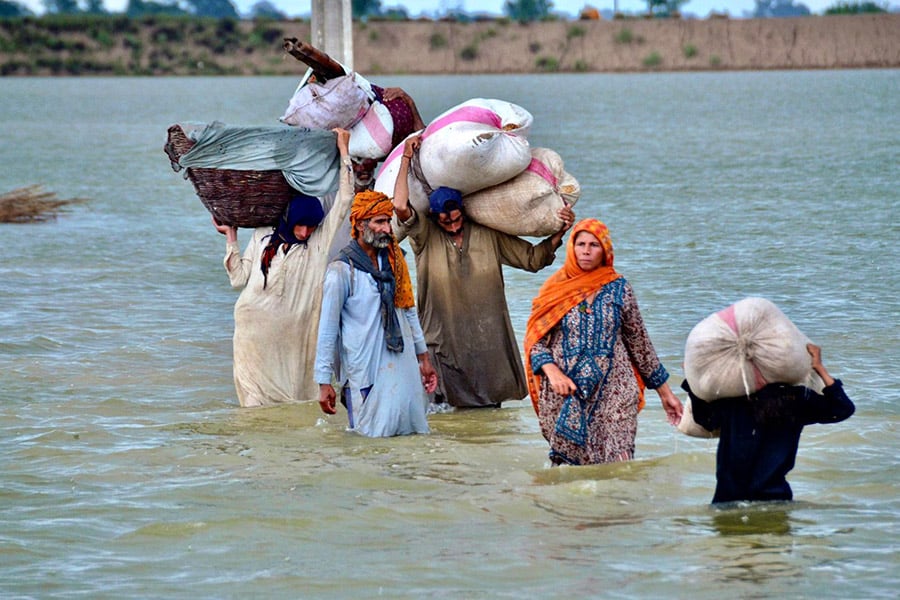
All four corners of Pakistan are underwater and one third of the country is estimated to be submerged due to an ongoing deluge that first began in June.
Pakistan’s climate change minister, Sherry Rehman, told The Guardian that the “monster monsoon was wreaking non-stop havoc throughout the country” with the most recent death toll reported by The National Disaster Management Authority set at 1,136 at the time of publishing.
The country is experiencing the worst flooding in more than a decade, with the crisis outstripping Pakistan's deadly floods in 2010 which killed 1700 people. Over 33 million people have been impacted by the monsoon, and nearly 500,000 people have been displaced, living in tents in relief camps while others have turned to friends and family for accommodation and safety. One million homes have been destroyed or damaged and around one million animals are estimated to have died, per The Guardian.
Of course, Pakistan is accustomed to monsoons, but the scale of this torrential rainfall is unprecedented. Ministers from the Pakistan government are chalking the extreme weather conditions up to climate change, which compounded with the destruction of river embankments and flash flooding, has left much of country reeling and cut off from aid, as 3500 km stretches of road has washed away.
What's more, is that despite the fact that Pakistan is responsible for only 0.4% of the world's CO2 emissions since 1959, they rank eighth on the Global Climate Risk Index which measures the countries that are most vulnerable to extreme weather conditions as the climate emergency worsens. This is particularly disturbing when you consider that the US has been responsible for 21.5%, the EU 15%, and Australia is positioned as the 14th highest CO2 emitter per capita in the world, despite only having a fraction of the population.
As Ahsan Iqbal, the planning and development minister in Pakistan says, “people are enjoying their lives in the west but someone here is paying the price".
How you can help
Australians know first hand just how devastating flooding can be, especially in the wake of the deadly northern rivers floods. We also know just how important donations and support are to rebuild during these critical times. As aid flows into Pakistan from countries like Turkey and the UAE, and the International Monetary Fund finally releases a long-anticipated $US1.17 billion for Pakistan, there are individual acts you can do, to follow suit and mobilise in Australia.
Below we've rounded up some ways to send assistance to those affected by the floods in Pakistan, if you're looking for ways to relieve some of the burden with the means you have.
United Nations' World Food Programme
In response to the unprecedented flooding, the United Nations' World Food Programme has begun a $232 million appeal to assist those affected in the provinces of Punjab, Sindh, Balochistan, and Khyber Pakhtunkhwa. If you can spare some much-need funds, donate here.
Prime Minister's Flood Relief Fund
Send assistance by going straight to the source. Pakistan's government has set up a fund for overseas donations. Read more about it at the link above.
Islamic Relief Australia
If you would like to support a local organisation, Islamic Relief Australia is accepting donations which will be put towards acquiring and sending medical supplies, food and adequate shelter to its emergency teams currently on the ground in Pakistan. They will then disseminate these supplies accordingly.
Crescent Relief
Crescent Relief is another organisation that's established a fund to send cash to households in dire straits. So far they've covered communities in Qilla Saifullah and Lasbela and are collecting information in preparation to aid those in South Punjab.
Purchase a ticket to the cricket
While it would make sense just to donate to an organisation of your choosing, you can also purchase a ticket to the upcoming September cricket match involving Pakistan at the T20 International in Karachi. In solidarity, the Pakistan Cricket Board has pledged all gate fees to the Prime Minister's Flood Relief Fund.
Image: Twitter



